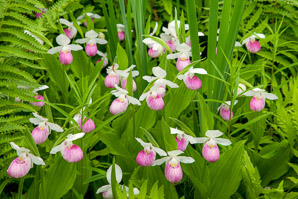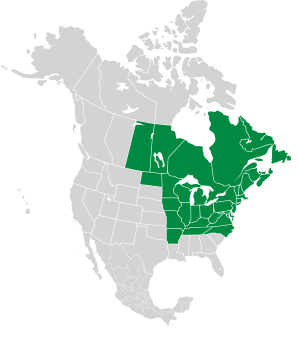
|
Cypripedium reginae Walter Showy lady’s slipper
Showy lady’s slipper is a rare North American native orchid. It prefers neutral or alkaline soils, and wetlands such as fens, wooded swamps, forests, and riverbanks, usually in partial shade. It grows slowly, taking as long as 16 years to produce its first blooms. From Wikipedia: “The plant is classified as imperiled or critically imperiled in Arkansas, Connecticut, Illinois, Iowa, Missouri, New Brunswick, New Hampshire, New Jersey, Newfoundland & Labrador, North Dakota, Nova Scotia, Ohio, Pennsylvania, Prince Edward Island, Saskatchewan, Tennessee, Virginia and West Virginia. It is considered vulnerable in Indiana, Maine, Manitoba, Massachusetts, New York, Quebec, Vermont, Wisconsin, Rhode Island, and several areas of eastern Canada. It is known to occur in only 14 locations in Massachusetts (as of 2016). It was historically found in Kentucky and North Carolina, but has not been found recently.” Plants: Plants are 8-35″ (21-90 cm) high. Many stems—rarely up to 200—emerge from the same root mass. Leaves: Each stem has 3-6 (rarely up to 9) alternate, pubescent (hairy) leaves. Each leaf is ovate, with parallel, deeply ribbed veins, 4-11″ (10-27 cm) × 1¾-6″ (5-16 cm). Stems and leaves are covered with thin hairs that can cause mild to severe dermatitis. Flowers: Each stem supports up to three white-topped, pink-pouched flowers. The upper white petals and sepals form a roughly flat top. Each petal is up to 1½″ (4 cm) long × ½″ (1.5 cm). The pouch-shaped lip, or labellum, is rose-pink to magenta, and ⅞-2″ (2.5-5.5 cm) long. These are distinguished from pink lady’s slipper (Cypripedium acaule) because showy lady’s slipper is large—flowers are up to 4″ (10 cm) across—and pink lady’s slipper has no white petals on top. Online References:
Goorchids.northamericanorchidcenter.org The U.S. Forest Service Celebrating Wildflowers site
Cypripedium reginae description by Thomas H. Kent, last updated 16 Dec 2020. © FloraFinder.org. All rights reserved. |
Preserved by the Nature Conservancy in Hartland, VT, USA · 6/17/2011 · Hartland, Vermont · By Susan Cole Kelly Range:
|



